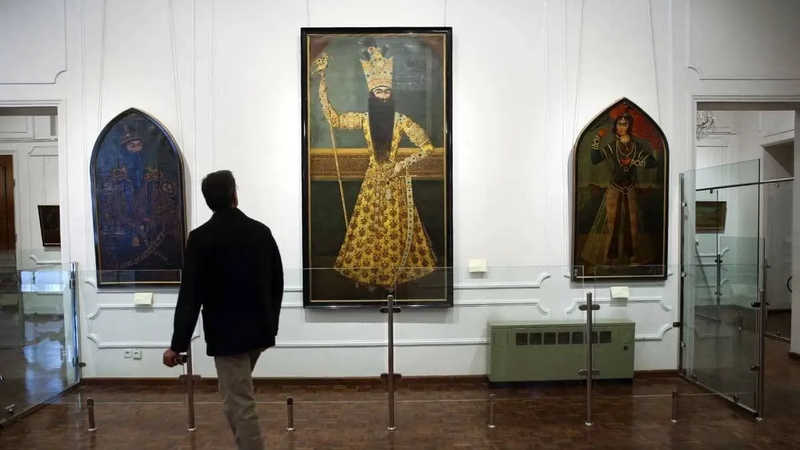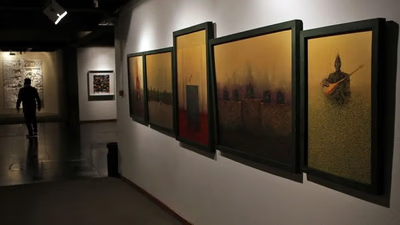
Diverse artistic styles in Middle Eastern paintings showcase cultural richness.
Islamic art has a significant presence in West Asia due to the dominant influence of Islam in the region. Islamic art is characterized by its emphasis on geometric patterns, calligraphy, and intricate designs. Paintings often feature stylized representations of plants, animals, and human figures. The use of vibrant colors, gold leaf, and decorative motifs is common in Islamic art. Persian miniature painting has a long history in West Asia, particularly in Iran. These small-scale paintings are highly detailed and typically depict scenes from epic poems, courtly life, and religious stories. Persian miniatures are known for their delicate brushwork, intricate patterns, and rich colors. They often feature figures with almond-shaped eyes and elongated proportions.
Arabesque is a distinctive decorative style found in various forms of West Asian art, including paintings. It is characterized by intricate, interlacing floral and geometric patterns. Arabesque motifs are often used to adorn borders, frames, and backgrounds in paintings. The style emphasizes the importance of balance, symmetry, and repetitive patterns. The Qajar dynasty, which ruled Persia (now Iran) from the late 18th to early 20th century, had a significant impact on the art of the region. Qajar art often features lavish, opulent scenes depicting court life, royal portraits, and historical events. The paintings are known for their detailed rendering of textiles, jewelry, and facial expressions. The color palette is rich and vibrant, with a focus on deep reds, blues, and gold.
Painting in the Middle East countries, as an ancient and diverse art, has created many types of styles throughout history and with different cultural and historical influences. Paintings in mosques and shrines in the Middle East usually belong to the styles of Islamic art and Islamic architectural art. These art styles are influenced by culture and Islam and have been developed by Muslim artists throughout history.
- Landscape paintings, natural landscapes and urban landscapes from Middle Eastern countries are depicted with detailed and colorful details. These paintings are usually done through watercolors, oil paints, or drawing with colored pencils.
- Religious and religious painting, which includes paintings that depict subjects related to religion and religious beliefs. For example, paintings depicting Islamic religious scenes or images related to other religions.
- Carving painting includes decorations and carving designs on different surfaces such as wood, metal and stone. Calligraphy and engraving paintings are usually seen in religious architecture and interior decorations of palaces and temples in the Middle East.
- The miniature painting depicts fictional and legendary scenes with very small and precise details. Miniature painting as a traditional and complex art is popular in countries like Iran, Turkey and India.
- Mystical painting focuses on mystical, spiritual and religious experiences. Mystic paintings are usually designed using symbols, Quranic verses and spiritual poems.
In the mosques and shrines of the Middle East, paintings with complex and beautiful geometric patterns and designs can be seen in the architecture. These paintings usually include geometric patterns and designs, linear decorations and religious symbols. In some mosques and shrines, there are large mural paintings on the walls and ceilings. These paintings usually include religious scenes, Quranic verses, flower designs and religious symbols and signs.
In some mosques and shrines, paintings with beautiful and decorative Arabic lines can be seen. These paintings usually include Quranic verses, God's names and holy words and phrases. In some shrines and mosques, miniature paintings with fine details are placed on textiles, inscriptions and papers. These paintings usually include religious scenes, images of religious historical events. In some mosques and shrines, there are paintings related to local rituals and customs. These paintings usually include images of religious ceremonies, local customs, local natural scenery, and symbols associated with local culture.
Other artistic styles can be seen in the mosques and shrines of the Middle East, which depend on the history and culture of each region and country. For example, in Iran , you can see paintings with gilded style and paintings with brown painting art style in some mosques and shrines. Also, in Arab countries, it is possible to see paintings in the style of Arabic classical art or decorations with special architectural motifs. This variety of artistic styles shows the richness and cultural and artistic diversity in the Middle East.
Sufism, a mystical branch of Islam, has influenced the art of West Asia, particularly in regions such as Turkey and Persia. Sufi art often aims to convey spiritual and metaphysical concepts through symbolic imagery. Paintings may depict dervishes in ecstatic dance, mystical landscapes, or calligraphic representations of religious texts. Sufi art often utilizes vibrant colors and abstract forms to evoke a sense of transcendence. In addition to traditional styles, West Asia has a thriving contemporary art scene. Contemporary artists from the region experiment with various mediums, styles, and themes, often exploring social, political, and cultural issues. Their works range from abstract and experimental to figurative and conceptual, reflecting the diversity of artistic expression in West Asia today.



